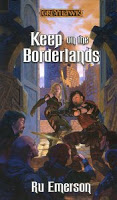Caution: Spoilers (both of the novel and the module on which it is based)
Next on our list of Greyhawk novels from the early 2000’s is Ru Emerson’s second title in the series; Keep on the Borderlands. I wasn’t a huge fan of her first effort, but was determined to give this one a fair shake. Unfortunately, it’s only marginally better than Against the Giants, and suffers from a unique problem as well.
As with the rest of the books in this series, the novel attempts to bring to life the classic D&D module Keep on the Borderlands. Beloved by many (indeed, many players name KotB as their favorite module of all time), the module has players exploring a system of caves stocked with various sorts of humanoids and other perils, very suitable for first-level adventurers, who return to the eponymous Keep to rest, heal, and restock their supplies.
The first half of the novel, on the other hand, is spent fighting bandits (two different bands of bandits? Three? The book is unclear), presumably merely to introduce the character of Blot (later renamed Flerys in a seeming attempt to deliberately confuse the reader), a young girl who had been living with the main group of bandits. The raids into the Caves of Chaos themselves seem almost perfunctory, taking a couple of pages to wipe out each band of humanoids, and then dispatching the priest of Chaos in similarly short order. The pacing is terrible, hearkening back to the earlier book.
That brings up one of the problems with the novel; we don’t find out until almost the end that there was, apparently, a steady stream of chaos cultists passing by the Keep on their way to the caves. It’s only mentioned in passing, just as the characters are heading into the final cave wherein lies… the temple of chaos. Despite the fact that this is actually highlighted on the back cover blurb of the book, it seems thrown in as an afterthought, when, if it had been mentioned earlier on, might have provided some much-needed narrative glue to hold the thing together. The ending, such as it is, comes abruptly and without any sort of fanfare. Ho-hum, the cleric we haven’t seen for the first two-thirds of the novel casts a spell and kills the evil cleric. Done.
The characters are slightly better defined than in Against the Giants. Eddis and M’Baddah seem interesting enough that I wouldn’t mind reading more about them, but the remainder of the party (including Emerson’s seemingly favorite trope, the mysterious twins with the special bond, just as we saw in the first novel) is pretty forgettable. What makes it worse is that it’s painfully obvious that the author is trying to make the rest of the characters stand out, but failing in the attempt.
Perhaps the biggest flaw in this addition to the line of Greyhawk novels is that it isn’t a Greyhawk novel at all. Although it has the Greyhawk logo on the cover, there is absolutely nothing to tie the novel to the setting. It is as completely generic as the original module, and while that is one of the module’s strengths, it leaves a bad taste in the mouth of a Greyhawk fan looking for material to use in an RPG campaign based on the promise that the novel actually takes place there.
On the whole, a dull read with the same sort of pacing problems that plagued its predecessor, that adds nothing to the Greyhawk milieu. Completest fans of the original module may get something out of it, but it’ll take some doing.
I rate it two wizards out of five.












Yeah, that one was pretty bad. I actually enjoyed all of the others, especially the Paul Kidd novels. Good stuff, though I know you weren't huge fan of Queen of the Demonweb Pits.
Too bad. Aside from Kidd, I wonder why they couldn't find better novelists to write those books… so many writers who played D&D would have jumped at the chance to write novelizations of classic modules.
I really loved Tomb of Horrors – hope you cover that one!
Reading Tomb of Horrors right now, as a matter of fact!